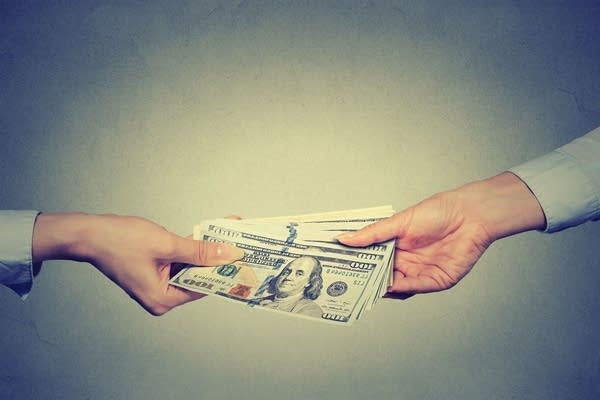The long, tangled story behind country-of-origin labels
“Made in” labels started as a way to protect domestic economies. Globalization has made it a lot more complicated.

This is just one of the stories from our “I’ve Always Wondered” series, where we tackle all of your questions about the world of business, no matter how big or small. Ever wondered if recycling is worth it? Or how store brands stack up against name brands? Check out more from the series here.
Listener and reader Helen Rasmussen from Portland, Maine, asks:
When and how did the ‘country of origin’ label and ‘made in’ label on our consumer goods become a thing? I remember the TV ads when I was a kid with the jingle “look for the union label” which was obviously pro-USA and pro-union, but I would not have thought it was required. Was it in response to foreign made goods? I also remember, because my parents dealt in antiques, them noting when items had a “made in Occupied Japan” label. Is this labeling required, and what is the backstory?
We live in a globalized world. You might be sitting down, wearing a shirt that says it was made in China, while browsing the internet using a laptop manufactured in India, next to a notepad and pencil made in Mexico.
Craig VanGrasstek, a trade consultant, joined Marketplace to explain the history behind this labeling.
Country-of-origin labels arose in the 19th century, when Germany started to rise as an industrial power, he said.
“So a lot of European countries began imposing these country-of-origin label requirements because they wanted their people to be able to know if products were being imported from Germany,” VanGrasstek added. “This inspired people in the United States.”
The first significant U.S. law that required products to be marked with their country of origin was the Tariff Act of 1890, also known as the McKinley Tariff (parts of which are still in effect), according to VanGrasstek.
The Tariff Act of 1930, which built on the 1890 law, required that “every article of foreign origin (or its container) imported into the U.S. shall be marked with its country of origin,” unless it had special exemptions. Retailers are responsible for the labels.
U.S. trade law is not clean-cut, VanGrasstek noted.
“What happens over time is U.S. law accretes, and gets interpreted, and gets revised in a variety of forms,” he explained.
When are country-of-origin labels required?
Generally, products the United States imports from other countries need labels, but most of the products made in the U.S. and sold domestically don’t (with the exception of automobiles, textiles, wool and fur products).
VanGrasstek noted that U.S. trade law doesn’t apply uniformly to all countries or certain food products.
Since the Tariff Act of 1930, “many, many other laws have been enacted at the federal and the state level,” VanGrasstek said. “Things also get modified by different interpretations of the regulatory agencies and by national courts, and also by the [World Trade Organization] in dispute settlements.”
For example, country-of-origin labeling is required on food products including the muscle cuts of lamb and chicken, wild and farm-raised fish, and fresh and frozen fruits and vegetables, according to the U.S. Department of Agriculture.
One notable exception? Beef. The USDA exempted beef in 2015 after the WTO ruled that the labeling gave U.S. beef and pork a marketing advantage over Canada and Mexico’s products. The two countries threatened $3 billion in retaliatory sanctions against the U.S.
As a consequence, beef products sold in the U.S. can be labeled as “Product of USA” even if they come from other countries, as long as the animal was slaughtered or the meat was repackaged or processed here. But the story isn’t over — a group of bipartisan senators announced legislation late last year that would reinstate mandatory country-of-origin labeling. House representatives also introduced a bipartisan version of this bill in March.
Jennifer Diaz, founder of Diaz Trade Law, pointed out that country-of-origin labels also aren’t required for online products. The Senate has passed a bipartisan bill that would include such a mandate, but it has yet to agree on a compromise bill with the House of Representatives, which has passed its own version.
Retailers including Amazon oppose the move. The National Retail Federation told a Senate committee that companies might source items from different countries, making it complicated to label a product, The Washington Post reported last year.
The placement matters too
Not only are there a series of rules governing when to use these labels, but sometimes there are stipulations on where they’re placed.
For example, Congress has enacted a law that requires manhole covers have country-of-origin labeling on the top.
“The purpose for that was to discourage municipal authorities in this country from buying manhole covers made outside this country,” VanGrasstek explained.
VanGrasstek also noted that in the 1980s, there was a law that required any iron or steel tube to have a permanent country-of-origin label, meant to discourage foreign imports. Delicate medical instruments like artificial heart pumps fell under this category, and marking the devices would ruin them, VanGrasstek explained.
“So in that particular case, there was finally a ruling that instead of permanently inscribing the made-in-label on these tubes — that no one would ever see because they go inside someone’s chest — they could instead affix a paper label,” he said, that doctors could remove.
The origins of the “Made in Occupied Japan” label
In 1945, after World War II ended, Gen. Douglas MacArthur was tasked with reviving Japan’s economy and set up headquarters in Tokyo. During the U.S. occupation, factories had to print “Occupied Japan” or “Made in Occupied Japan” labels for their products, including ceramic figurines and toys that mimicked American and European aesthetics, according to the Chicago Tribune.
The Mercury News in California reported in 2017 that products with the label were valuable and treasured by collectors until the 1980s and 1990s, when replicas entered the market.
If you scroll through eBay, you can still find these items for sale.
A brief history of the union label
As reader Helen Rasmussen recalled, TV commercials once featured ads by the International Ladies’ Garment Workers’ Union that encouraged people to “look for the union label.”
VanGrasstek explained that the union label wasn’t necessarily about encouraging people to buy domestic goods over imported ones, but more about whether the item you purchased was from a union shop versus a nonunion shop.
Back in 1874, San Francisco cigar makers created a “white labor” label to indicate that their products were created by unionized white men, not nonunion Chinese workers, according to United Food and Commercial Workers International Union Local 324.
By 1880, the Cigar Makers International Union got rid of the “racially motivated white label” and developed a blue national union label. In 1909, the American Federation of Labor created a department to promote the union label.
“Today, the union label represents a broad, multi-ethnic labor force. While we know it as a symbol for products made by union workers, it is also symbolic of labor’s past,” the UFCW Local 324 website states. “Even in its birth, with the struggle for the 8-hour day and the ‘white-labor’ label, the union label represents the movement’s mixed history of pride and shame.”
How the country-of-origin label is like a hammer
The question of where a product came from is complicated, depending on the trade rules governing the point in time when you asked that question, or how you define a country’s origins in the first place.
Take something as simple as a T-shirt, VanGrasstek said.
“Is the shirt American-made because it was sewn in this country? Or is it American-made because the fabric was woven in this country? Or is it American-made because the fiber that composes that fabric had been grown or otherwise produced in this country?” he said.
There are benefits to labeling. For one, VanGrasstek said it can provide useful information to consumers. If it’s made in the U.S., it can also give a slight bump to a product’s value.
The University of Chicago Booth School of Business published a study in 2020 looking at the worth of the “Made in USA” label. Researchers ran a field experiment for screen protectors on eBay, finding that the items with the USA label sold for 7 cents more.
But VanGrasstek said that sometimes country-of-origin labeling can be misused, perhaps as a ploy to appeal to “raw nationalism or xenophobia.” You can compare the label to a hammer or other tool, he said.
“A tool can be used properly — or abused.”













